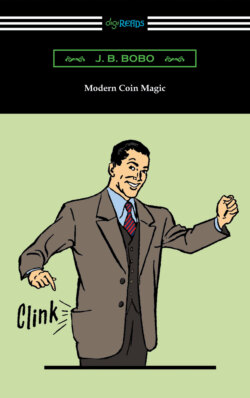Читать книгу Modern Coin Magic - J. B. Bobo - Страница 17
На сайте Литреса книга снята с продажи.
THE BACK PALM
ОглавлениеThe coin is hidden behind the hand, being held flat against the second and third fingers by the tips of the first and fourth fingers which press together against opposite edges, Fig. 1.
To get the coin in this position start with it in the front finger hold, Fig. 2. Bend the second and third fingers inward, then outward, passing them from one side to the other of the coin, which revolves in this action between the tips of the outer two digits, Fig. 3. When the fingers straighten out the coin will be hidden behind the hand, Fig. 1, as you show the front of the hand empty, Fig. 4. A slight upward movement of the hand as if tossing the coin into the air will cover the action of back palming.
To show the back of the hand, reverse the moves as follows: With the palm toward the front, bend the hand downward at the wrist as far as it will go, Fig. 5, and close the hand as it continues to turn until it becomes a loose fist, as illustrated in Fig. 6. At this point the two middle fingers bend inward and outward, revolving the coin between the first and fourth fingers as the hand completes its turning and the fingers are straightened out. The back of the hand is seen as in Fig. 7. All these moves must blend together in the one action of turning over the hand to show its back.
An alternate and preferred method of showing the back of the hand is as follows: After the palm is shown, begin turning the hand to show its back just as described above until the position depicted in Fig. 6 is reached. Bend the thumb upward over the lower edge of the coin and release it from the fingers so it can be thumb palmed as the fingers are extended to show the back of the hand. In other words, the coin is transferred from the back palm to the thumb palm as the hand turns over. This method is not only easier but has several advantages as a trial will show.
To show the front of the hand again, do this: Bend the fingers inward, grip the coin by its edge between the tips of the first two digits and turn it parallel with the floor as the thumb releases its grip and moves out of the way. Now bring the thumb back and press it against the edge of the coin, holding it in the Downs palm position. Still keeping the first finger below and the second finger above the coin, close the hand into a tighter fist and turn it palm toward the audience before straightening the fingers. The position of these two fingers prevents the spectators from getting a flash of silver as the hand is turned palm outward. At the completion of these moves the spectators see the hand as depicted in The Downs Palm, Fig. 3.
To produce the coin simply pluck it from the air as described in The Downs Palm.
All hands are not the same size, consequently all hands cannot handle the same size coin. For most, a half dollar will be just about right, while others will require a larger coin like the silver dollar. The Mexican Peso is slightly larger than the half dollar and the Canadian silver dollar is a trifle smaller than the American coin of the same value. It is advisable to use as large a coin as can be safely handled.
Many interesting foreign coins can be purchased for small sums at coin shops, some almost as cheaply as palming coins. Most coin manipulators prefer real money over the magic shop variety. Palming coins are usually suspected by the layman as being manufactured for magical purposes and for that reason are not recommended for close-up work.
Foreign coins also offer wonderful patter possibilities. Some of the coins available are quite beautiful and interesting in themselves. Use a few foreign coins and weave a story around them—you will find that the spectators will be much more enthusiastic about the trick.
